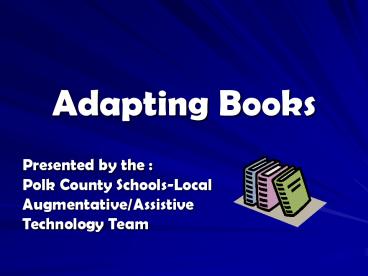Adapting Books - PowerPoint PPT Presentation
1 / 24
Title:
Adapting Books
Description:
Have additional symbols available to match with those in the adapted book. ... Velcro sensitive fabric to cover lap trays and male Velcro on the back of the book. ... – PowerPoint PPT presentation
Number of Views:160
Avg rating:3.0/5.0
Title: Adapting Books
1
Adapting Books
- Presented by the
- Polk County Schools-Local
- Augmentative/Assistive
- Technology Team
2
Resources for the presentation
- Materials used in the presentation and your
handout packet were from workshops presented by - Patti King-DeBaun
- Linda Burkhart
- Caryolyn Musselwhite
- Elizabeth S. Rush
3
No Child it too low or too involved to
participate in early literacy activities!
- Pattie King-DeBaun
4
The Pleasure of Books
- Learning to associate books with pleasure is an
important emergent literacy skill. We can show
children that books are full of wonderful things
and share books with children at what ever level
they are able to enjoy them. - Linda Burkhart
5
Supported Story Readings
- Supported story reading utilize books for
literacy/language learning. These books which
carry a theme should be used for repeated reading
experiences, developing literacy related
extension activities and for communication/languag
e learning goals
6
Strategies for Supported Story Readings
- small group- learning works best when introduced
in small groups of no more than three or four
children.
7
- Repeated Readings- When children are allowed to
select the stories to read with partners they
frequently choose the same ones over and over
again, sometimes fatiguing parents or other
readers.
8
- Repeated reading is a very productive strategy in
supporting language and literacy development. - It gives the child the opportunity to establish
and practice powerful strategies that they will
later use. - It is more likely to bore the adult.
- Research reports that children prefer multiple
readings of their favorite stories rather than
book of the day approach.
9
Storybook Centered Thematic Approach
- Musselwhite and King-Debaun (1997) distinguished
between two basic categories of books based on
how they are used for Supported Story Reading - Books for enjoyment/enrichment
- Books for literacy/language learning
10
Books for Literacy/Language Learning
- These books carry a theme.
- Should be used for repeated reading experiences.
- Attention is given to content and text of the
story. - Features predictable text, repeated text, simple
text, and simple graphics.
11
- Scaffolding or prompting is used to involve the
reader. - The adult gradually reduces hid responsibility in
reading and gives more responsibility to the
child.
12
- Primary goal is building on emergent literacy
skills book handling, book reading skills,
linking text with graphics, and building language
concepts. - Literacy learning occurs in an incidental manner
13
Guidelines when adapting books
- Selecting Books
- Consider readers interest or appeal.
- Identify age appropriate topics and graphics.
- Look for books that are predictable.
14
- Selecting Symbols
- Single symbol adaptations
- Use a single symbol for each page for early
emergent readers. - Identify what concept to teach nouns, verbs,
descriptors, etc. - Use same symbol for a repeated line.
15
- Multiple word Adaptations
- Identify books that support transition to use 2
or 3 symbols - To aide in reading in sequence find books that
have one short sentence per page.
- Word for Word adaptation
- Attempts to keep symbols on a single line by
making cells smaller for little words.
16
- Basics for symbols
- Early readers scan the image of the character of
the story. - Use the color symbols with words in black ink.
- Use a symbol for the cover.
- Use The End symbol on the inside back cover.
- Use a Read Again symbol on the back cover.
17
Adding Symbols
- Below Book If possible add the symbol below the
book so the symbols dont become buried in the
graphics. - In a Book
- Make symbols visually apparent.
- Use Velcro to easily attach or detach symbol.
18
Using Symbols
- Have additional symbols available to match with
those in the adapted book. - To support text use a large front label the
symbol.
19
General Guidelines
- Velcro place soft/female Velcro on the surface
of the book. Place the rough/male Velcro on the
symbol. - Use software to support adapting books like
Boardmaker or Writing with Symbols. - Laminate books or use soft contact to save on
wear and tear.
20
Physical Adaptations
- Books Stands
- Use foam wedges with Velcro to secure the books.
- Velcro sensitive fabric to cover lap trays and
male Velcro on the back of the book. - Purchase stands.
21
- Book Fluffers items between pages to help with
turning pages. - Sturdy make books sturdy using 7 mil laminate or
card stock.
22
BE AN ACTOR WHEN READING!
- Dont hesitate to be an actor when reading to
children. Vary your voice, whisper to draw in the
attention of the children and show emotion in
your voice to simulate what the characters are
feeling. Communicate to the children that this is
neat and he is fun to read and write with.
23
(No Transcript)
24
Show and Tell







![⚡Read✔[PDF] Aging in Place: Designing, Adapting, and Enhancing the Home Environment PowerPoint PPT Presentation](https://s3.amazonaws.com/images.powershow.com/10046689.th0.jpg?_=20240603058)























